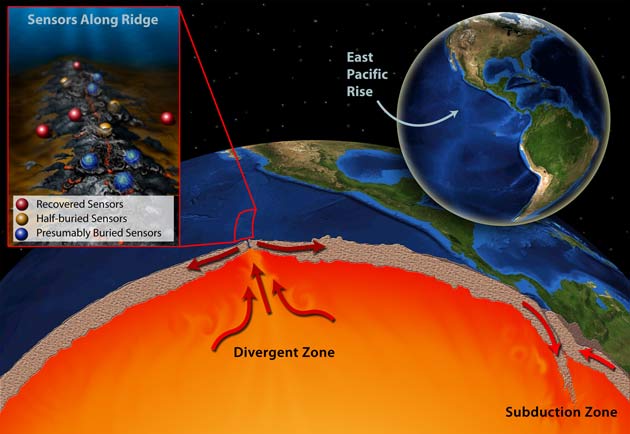Deep-Sea Eruption Detected in Progress

Scientists made their first discovery of a volcanic eruption in progress 1.5 miles below the surface of the Pacific Ocean.
The event was predicted at a site where earthquake activity had increased. The eruption was confirmed when eight of 12 seismometers deployed to the seafloor were apparently buried. Other similar projects had experienced a 98 percent success rate in recovering the devices, so scientists assumed the missing ones were covered by magma.
The eruption, in April, was reported recently in an online paper published by the journal Science. Geologist Maya Tolstoy of the Lamont-Doherty Earth Observatory, led the work.
"If you have to lose instruments on the sea bottom," Tolstoy said, "this is the only way to do it—when the information gained from their loss is extensive. The disappearance of these instruments underscores the importance of real-time monitoring on the sea floor. We learned an enormous amount by having these instruments placed where they were: right on top of the eruption."
The seismometers are part of an ongoing, detailed study of the creation of new sea floor at the East Pacific Rise, where the sea floor spreads apart [graphic]. The research is sponsored by the National Science Foundation.
The work has "exciting implications that we may be able to anticipate future sea floor eruptions," said co-author James Cowen of the University of Hawaii.
The finding is supported by chemistry changes in fluid from vents in the area measured in 2006 compared with 1991. As seawater heated by subsurface magma jets out from cracks in the ocean crust, it rises, then spreads out in a cloudlike formation that can rise more than 200 yards above the seafloor [see video of such an event]. The April eruption generated a cloud that was detected 4 miles to the south.
Get the world’s most fascinating discoveries delivered straight to your inbox.
Furthermore, rocks collected from the site were glassy and iridescent, indicating very recent cooling of hot magma by contact with cold seawater, the scientists explained.
- Underwater Volcano Erupts on Video
- Images: Wild Volcanoes
- All About Volcanoes
- Volcano Quiz

